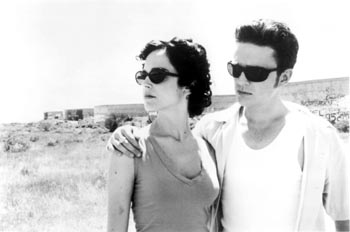
On the Lam: Nikki (Frances O'Connor) and Al (Matt Day) don't know whether in kiss or to kill each other on the road in Australia.
Too much symbolism sinks Australian thriller 'Kiss or Kill'
BIG ASPIRATIONS mark the new thriller Kiss or Kill, which comes to America bedecked with several Australian Academy Awards. This is the first film about criminals on the lam to begin with a Dylan Thomas poem: "We watch the show of shadows kiss or kill / Flavored of celluloid, give love the lie." The high-toned quote is a symbol of the singular lack of grit in this road thriller.
Kiss or Kill depends on a slightly plausible plot hook that asks which of two fleeing robbers might be a murderer: an angry woman, traumatized in her childhood, killing unconsciously in her sleep, or her lover, a nice guy given to sudden rages?
Nikki (Frances O'Connor) picks up businessmen, drugging them and rolling them. Her boyfriend, Al (Matt Day), comes in to take her away after one job, only to find that she's fatally overmedicated one of the marks. The two flee along Australia's south coast. They bring with them a little money and a big prize they've stolen from the dead man: a video of a beloved football star in bed with a 10-year-old boy.
Nikki decides to phone the star's sporting-goods store to boast about having the tape. She's interrupted by Al too late, and the damage is done. Soon the couple is being pursued not only by the police but also by the gun-wielding footballer. Wherever they stop, people turn up murdered, and neither one knows if the other is responsible.
The type of '40s melodrama that Kiss or Kill is modeled on depicts a society out of whack, in which criminals respond to the same signals the law-abiding get: to consume, to be aggressive and to protect their loved ones. The problem is that they respond to those signals in all the wrong ways.
Nikki and Al, however, don't have much society to be in conflict with. The (moral) desert they drive through is often pretty, and the people are as willing to help them as to judge them. I also don't feel like saluting another symbolic flag run up by director Bill Bennett: some of the action in Kiss or Kill takes place on a nuclear test site. While the threat of imminent nuclear war once justified existential bad behavior, this old cinematic gaff has lost its sharpness over the years.
Eventually, the police trying to capture Nikki and Al get our best wishes. The pair are played by Chris Haywood and Andrew S. Gilbert, much more engaging actors than the leads, the Ida Lupino-like O'Connor and the bland hunk Day, both veterans of the enervating "my so-called angst" college movie Love and Other Disasters.
Maybe that Australian national symbol, the kangaroo, influenced Bennett's extreme use of jump cuts. The absence of music on the soundtrack helps to give the film a bit more authenticity. A few supporting actors also threaten to elevate the movie with some quirky bits. John Clark as an Aborigine tracker named Possum Harry steals the show with a handful of half-mumbled dialogue. By the time a dozen coincidences and improbabilities yield an unlikely happy ending, you'll wish Bennett had stuck with Possum Harry for the entire film.
Kiss or Kill (R; 93 min.), directed and written by Bill Bennett, photographed by Malcom McCullough and starring Frances O'Connor and Matt Day.
[ Metro | Metroactive Central | Archives ]
![[Metroactive Movies]](/movies/gifs/movies468.gif)